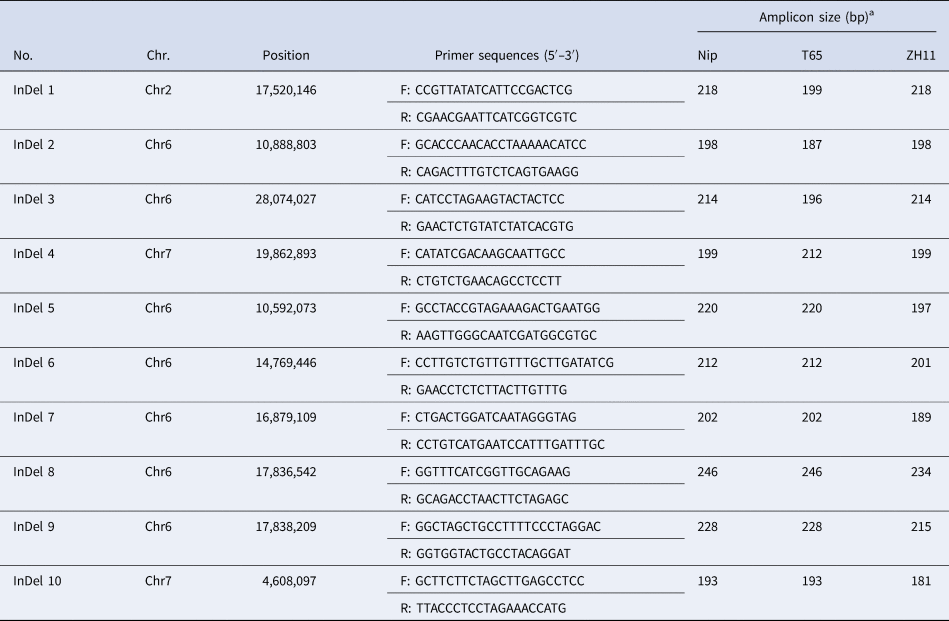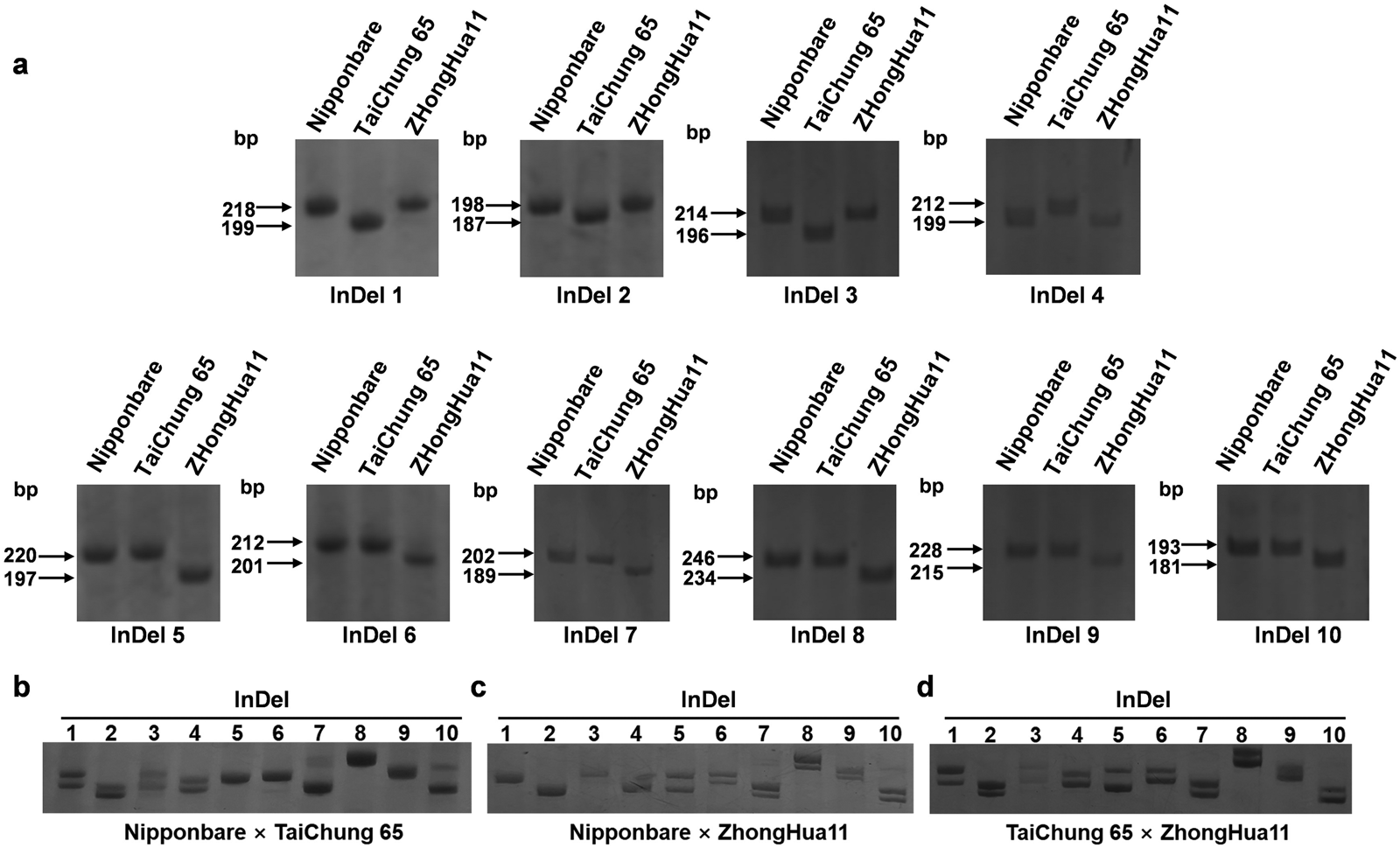Introduction
Rice (Oryza sativa L.) is one of the most important food crops in the world. Breeding efforts for high-yield rice varieties with superior quality have been growing annually, posing more risks to genetic purity maintenance for seed lots (Liu et al., Reference Liu, Zeng, Wu, Li and Chen2021). In traditional rice breeding programmes, the genetic purity testing is mainly based on breeders’ perception of morphological traits, such as plant architecture, panicle size and grain size (Sun et al., Reference Sun, Gu, Wang, Xu, Luo, Yang, Shen and Duanmu2014; Liu et al., Reference Liu, Zeng, Wu, Li and Chen2021). However, rice varieties show differences great in growth patterns, biochemical characteristics and resistance to stresses due to different geographical growth conditions, which affects the characterization of morphological traits (Li et al., Reference Li, Wu, Wang, Sun, Xia, Geng, Wang, Xu and Xu2018).
In recent decades, the use of molecular markers has become one of the most sensitive, powerful technologies for genetic purity testing (Yashitola et al., Reference Yashitola, Thirumurugan, Sundaram, Naseerullah and Ramesha2002). These markers have been widely used in genetic analyses and marker-assisted breeding of a range of crops, including rice (Gull et al., Reference Gull, Haider, Gu, Raza Khan, Miao, Tan, Uddin, Ahmad and Liang2019; Hechanova et al., Reference Hechanova, Bhattarai, Simon, Clave, Karunarathne, Ahn, Li, Lee, Kohli, Hamilton, Hernandez, Gregorio, Jena, An and Kim2021), maize (Baveja et al., Reference Baveja, Muthusamy, Panda, Zunjare, Das, Chhabra, Mishra, Mehta, Saha and Hossain2021), soybean (Sohn et al., Reference Sohn, Kim, Hwang, Park, Lee, Markkandan, Lee, Lee, Hong, Song, Koo and Kim2017) and cucumber (Adedze et al., Reference Adedze, Lu, Xia, Sun, Nchongboh, Alam, Liu, Yang, Zhang, Deng, Li and Si2021). Insertion and deletion (InDel) molecular markers, which exert detection based on PCR and gel electrophoresis techniques, are of more practical value to researchers and breeders. Currently, a number of InDel markers have been developed to assist rice breeding (Wu et al., Reference Wu, Wu, Wang, Tseng and Hwu2013; Liu et al., Reference Liu, Li, Qu and Yan2015), but most of them are not suitable for discriminating different japonica rice varieties. Nipponbare (136.54°E, 35.10°N), TaiChung 65(120.57°E, 24.16°N) and Zhonghua11(116.30°E, 39.40°N) are three typical temperate japonica rice varieties (Wang et al., Reference Wang, Mauleon, Hu, Chebotarov, Tai, Wu, Li, Zheng, Fuentes, Zhang, Mansueto, Copetti, Sanciangco, Palis, Xu, Sun, Fu, Zhang, Gao, Zhao, Shen, Cui, Yu, Li, Chen, Detras, Zhou, Zhang, Zhao, Kudrna, Wang, Li, Jia, Lu, He, Dong, Xu, Li, Wang, Shi, Li, Zhang, Lee, Hu, Poliakov, Dubchak, Ulat, Borja, Mendoza, Ali, Li, Gao, Niu, Yue, Naredo, Talag, Wang, Li, Fang, Yin, Glaszmann, Zhang, Li, Hamilton, Wing, Ruan, Zhang, Wei, Alexandrov, McNally, Li and Leung2018; Mao et al., Reference Mao, Xin, Tan, Hu, Bai, Liu, Yu, Li, Peng, Fan, Zhu, Guo, Wang, Lu, Xing, Yuan and Chen2019), which are widely applied in characterization of gene function due to their excellent traits and relatively complete genomic information. However, due to the high similarity in morphological phenotypes, such as grain size and seedling morphology, among the three japonica rice varieties, it is not easy to distinguish them in the field. Therefore, the main objectives of this study were to develop an effective, convenient method for genetic purity detection of the seed lots for these three types of japonica rice varieties and their intercross hybrid progenies (F 1).
Experimental process
In this study, the published whole genome sequences of the three japonica rice varieties, Nipponbare (RefSeq assembly accession: GCF_001433935.1), Taichung 65 (BioSample: SAMD00222499) and Zhonghua11 (BioSample: SAMN23898207; Sample name: PABE3rep_3; SRA: SRS11288865), were aligned using BWA-MEM (Li, Reference Li2013) with default parameters. Subsequently, InDels of more than 10 bp in size and with a sequencing depth no less than 3× were screened out using the mpileup function of SAMtools in combination with in-house Python scripts. Finally, the InDel markers identified were manually inspected by the tview function of SAMtools. The marker-specific primer pairs were designed using the Primer3 2.3.4 (Rozen and Skaletsky, Reference Rozen and Skaletsky2000) (Table 1) with the following criteria: PCR product length of 200 ± 50 bp and primer annealing temperature ranging between 50 and 65°C.
Table 1. Detailed information of the InDel markers identified

aNip, Nipponbare; T65, TaiChung 65; ZH11, Zhonghua11.
The rice materials used this study were planted at the Main Campus Teaching & Research Base of South China Agricultural University, Guangzhou, China (23.13°N, 113.27°E). Genomic DNA was extracted according to the high-throughput plant genomic DNA preparation method (Wang et al., Reference Wang, Chu, Ma, Li and Liu2013). The PCR reaction system (10 μl) included: 5 μl of 2 × Taq PCR StarMix (GenStar, China), 0.2 μl of 0.2 μmol/l each primer, 0.5 μl of genomic DNA and 4.1 μl of ddH2O. The PCR reaction conditions were as follows: pre-denaturation at 95°C for 3 min; 32 cycles of 95°C for 30 s, 58°C for 30 s and 72°C for 30 s and final extension at 72°C for 2 min. The PCR products were analysed by 10% SDS-polyacrylamide gel electrophoresis (Bassam et al., Reference Bassam, Caetano-Anollés and Gresshoff1991).
Discussion
As an effective tool for genetic research, molecular markers have been widely used in genetic diversity analyses, molecular marker-assisted breeding and genetic purity evaluation. Compared with traditional molecular markers such as Restriction Fragment Length Polymorphism marker, Random Amplified Polymorphic DNA marker and Cleaved Amplified Polymorphic Sequence marker, InDel molecular markers provide more convenient and rapid detections. Because of the rich genetic diversity between rice subspecies indica rice and japonica rice, it is relatively easy to develop InDel markers capable of distinguishing indica rice from japonica rice. At present, many excellent japonica rice varieties are selected by breeders through crossbreeding related excellent japonica varieties, which has greatly reduced the genetic diversity of japonica rice varieties, thus posing a challenge in developing DNA markers to distinguish different japonica rice varieties (Yamamoto et al., Reference Yamamoto, Nagasaki, Yonemaru, Ebana, Nakajima, Shibaya and Yano2010; Arai-Kichise et al., Reference Arai-Kichise, Shiwa, Nagasaki, Ebana, Yoshikawa, Yano and Wakasa2011). A study reported 26 InDel markers that could classify some japonica rice varieties from different geographic regions into three lineage groups, GJ-I, GJ-II and GJ-III (Yuan et al., Reference Yuan, Yang, Zou, Cheng, Fan, Liang, Yu, Qiu, Li and Hu2021); However, these markers are not applicable to distinguish specific japonica rice varieties. Cheon et al. (Reference Cheon, Jeong, Oh, Oh, Kang, Kim, Lee, Baek, Kim and Choi2020) reported 454 Kompetitive allele-specific PCR (KASP) marker for identifying temperate japonica rice varieties. However, genotyping using this method requires PCR amplification with specific KASP reagents (Steele et al., Reference Steele, Quinton Tulloch, Amgai, Dhakal, Khatiwada, Vyas, Heine and Witcombe2018). The three japonica rice varieties Nipponbare, Taichung 65 and Zhonghua11, only show observable differences at the reproductive and ripening stages (online Supplementary Fig. S1b and c), while no difference can be detected in seedling morphology (online Supplementary Fig. S1a) and grain size (online Supplementary Fig. S1d and e); therefore breeders have to go through all the three growth stages for genetic purity assessment.
In this study, we developed 22 InDel markers from three typical japonica rice varieties by BWA-MEM in combination with SAMtools and Python scripts (online Supplementary Table S1). Further, we confirmed 10 of these markers that can rapidly distinguish among Nipponbare, Taichung 65, Zhonghua 11 and their hybrid progenies (Table 1). The sizes of products obtained from PCR amplifications using these 10 InDel markers on genomic DNA of Nipponbare, TaiChung 65 and Zhonghua 11 were consistent with those estimated by our bioinformatics tools (Fig. 1(a)), indicating the applicability of these markers to molecularly characterize these three japonica rice varieties. These markers also exhibited polymorphisms in the hybrid progenies (F 1) derived from intercrosses of Nipponbare × TaiChung 65 (markers 1, 2, 3 and 4) (Fig. 1(b)), Nipponbare × Zhonghua11 (markers 5, 6, 7, 8, 9 and 10) (Fig. 1(c)) and TaiChung 65 × Zhonghua11 (all 10 InDel markers) (Fig. 1(d)).

Fig. 1. Performance of all ten InDel markers in the three rice varieties (a) and the F 1 progenies derived from intercrosses of Nipponbare × TaiChung 65 (b), Nipponbare × Zhonghua11 (c) and TaiChung 65 × Zhonghua11 (d).
The InDel markers developed in this study may serve a powerful tool for advancing molecular marker-assisted rice breeding and evaluating the genetic purity of rice varieties. At the same time, we provide a novel strategy for applying next-generation sequencing data to genetic purity assessment of seed lots.
Supplementary material
The supplementary material for this article can be found at https://doi.org/10.1017/S1479262123000096.
Acknowledgements
This research was supported by the Laboratory of Lingnan Modern Agriculture Project (NT2021002), the Key Research Program of Guangzhou Science Technology and Innovation Commission (201904020030) and the lateral research funds (H2020793 and H2020805). The authors thank Chen JH for providing technical support. The authors would like to thank TopEdit (www.topeditsci.com) for its linguistic assistance during the preparation of this manuscript.




